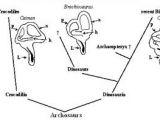They had feathers and a complex behavior.
Now scientists are decoding their sensory abilities.
A team at the University of Maryland led by professor Robert Dooling claims that dinosaurs probably heard many low frequency sounds, like the heavy footsteps of another dinosaurs, but they were unable to detect the high pitched sounds that birds make.
The team reached this conclusion based on researches made on bird hearing.
Dinosaurs, birds (their descendants) and crocodiles (which share the same roots with the dinosaurs) had a very similar ear structure.
By comparing their ears and applying other rules of hearing, the scientists could imagine the auditive range of the dinosaurs. "The best guess is that dinosaurs were probably somewhat similar to some of the very large mammals of today, such as the elephants, but with poorer high frequency hearing than most mammals of today. As a general rule, animals can hear the sounds they produce. Dinosaurs probably also could hear very well the footsteps of other dinosaurs. Elephants, for instance, are purported to be able to hear, over great distances, the very low frequency infrasound generated by the footsteps of other elephants.", said Dooling.
This team investigates the evolution of hearing in living organisms. The investigation focused on the part of the inner ear named the basilar membrane to assess dinosaur hearing. Small species with a short basilar membrane (like birds) detect higher frequencies than larger species with a longer basilar membrane (like most dinosaurs). "As a general rule, large organisms hear best and produce sounds at lower frequencies, while smaller organisms hear best and produce sounds at higher frequencies. General physical principles suggest that small, lightweight structures for producing sound can be moved at higher frequencies using less energy than can large, heavy structures." said Dooling.
The dinosaur's hearing range probably went no upper than the frequency of a conventional telephone, about 3 kHz. The limit for humans is 20 kHz.
"Dogs and many other mammals extends to frequencies in the ultrasonic range above 20 kHz, much higher than in humans and archosaurs. The high frequency limit in birds is below that of normal hearing humans, and large dinosaurs have an even more restricted range of high frequency hearing, well below that of humans."
"Interestingly, we sometimes irreverently refer to aging humans as 'dinosaurs. In fact, as humans age in our noisy environment, we begin to lose our hearing at high frequencies. So, in a sense, our hearing becomes more like that of the dinosaurs", Dooling said.

 14 DAY TRIAL //
14 DAY TRIAL // 
